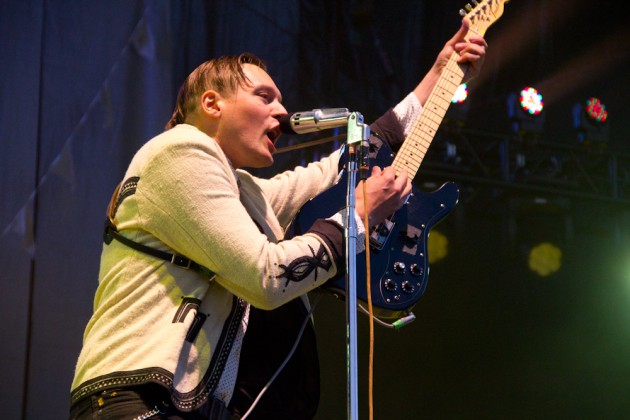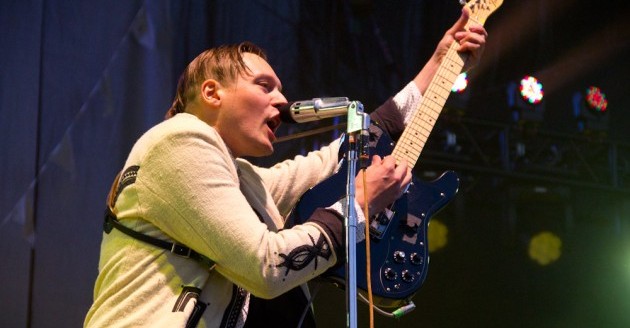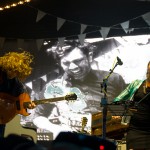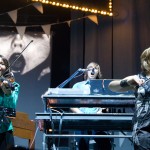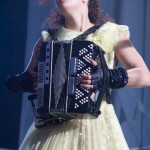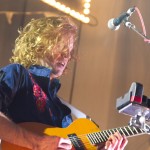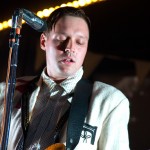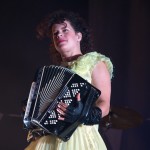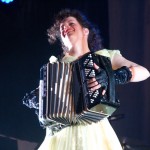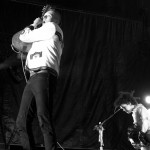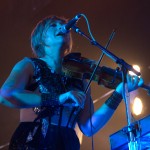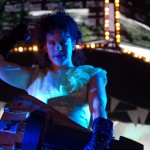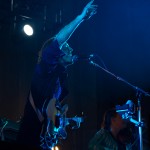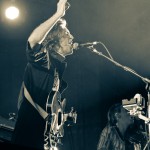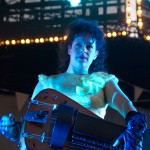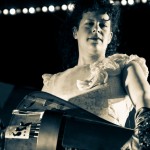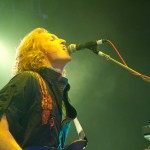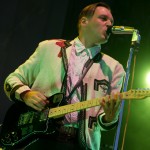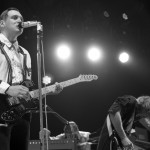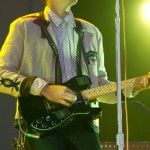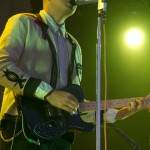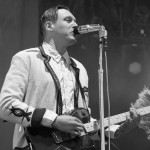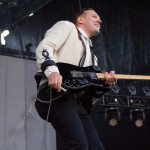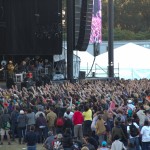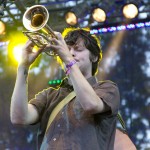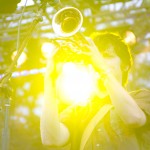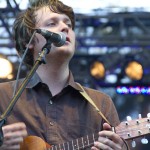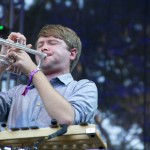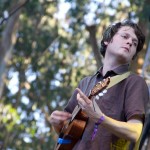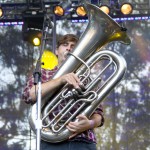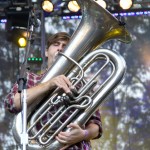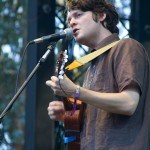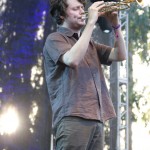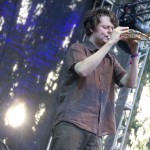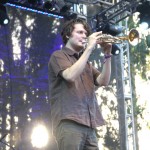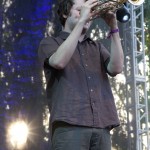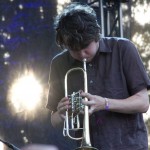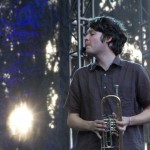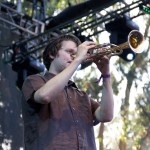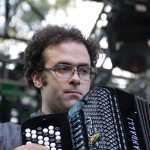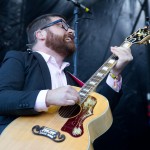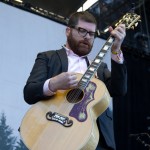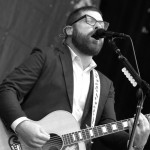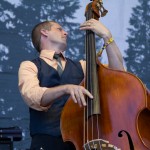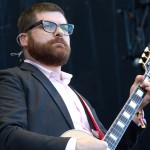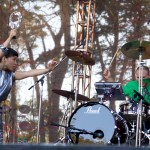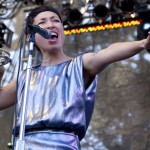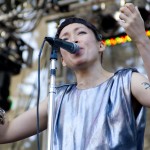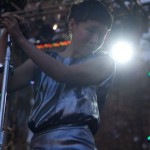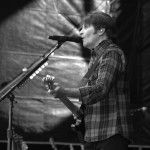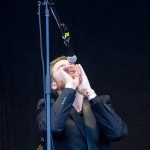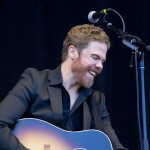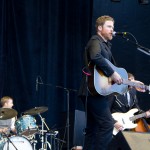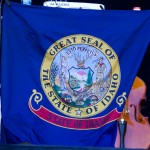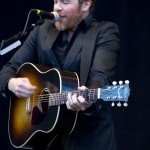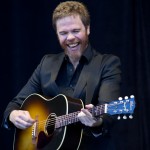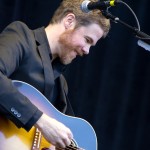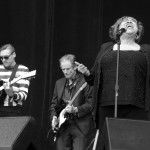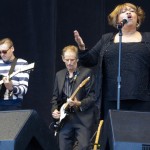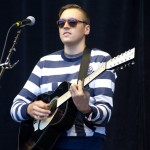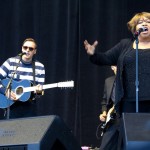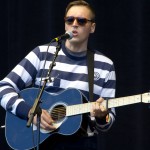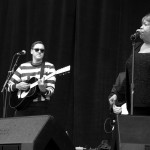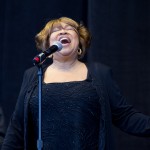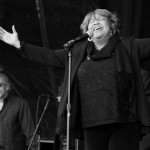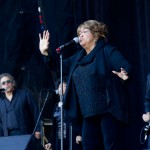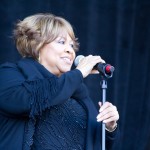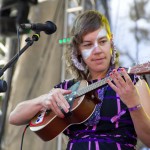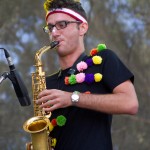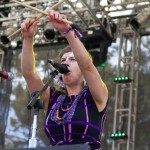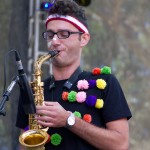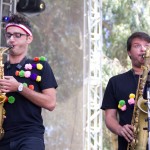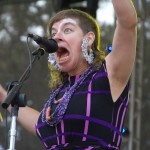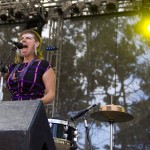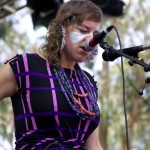This post is powered by Best Buy
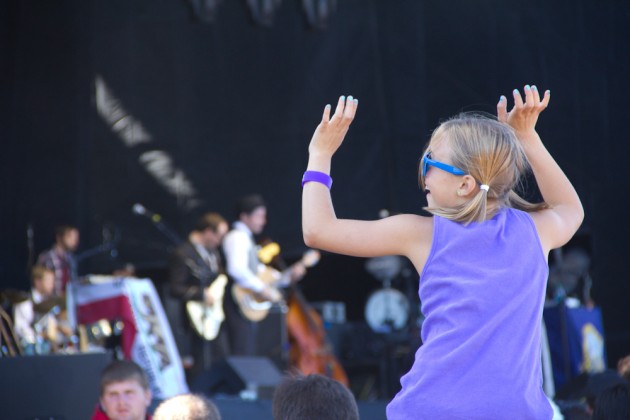
All Photos by Philip Cosores
Sunday at Outside Lands provided a slew of acts that fall into a quite specified niche: bands that make music that is interesting not only to dance to, but also to merely stand and admire. Those who still had the energy will have found many moments and songs in which to expend it, while those nearing exhaustion will have experienced plenty of other edification from the musicianship, lyrics and general vibrancy of everything around them. Sunday was the best day of Outside Lands 2011, and considering the amount of praise I’ve already heaped upon Friday and Saturday, that’s quite an achievement.
The Fresh & Onlys
The Fresh & Onlys’ set at noon on Sunday was not only special because they got to open the final day of the festival, but also because for them it is a hometown show. The sun was high in the sky as The Fresh & Onlys performed, and their slightly-tropical garage rock seemed to grow in ferocity as the set progressed. The early-set performance of fan-favourite “Waterfall” was quite relaxed and suited the relaxed atmosphere, but by the end of the set when the band put out strong renditions of psych-heavy jams including “Peacock and Wing” the atmosphere had completely changed, and the crowd went with it. The increased volume suited the band as they came to life on stage and the crowd reciprocated. All in all it was just what was needed to kick start the final day.
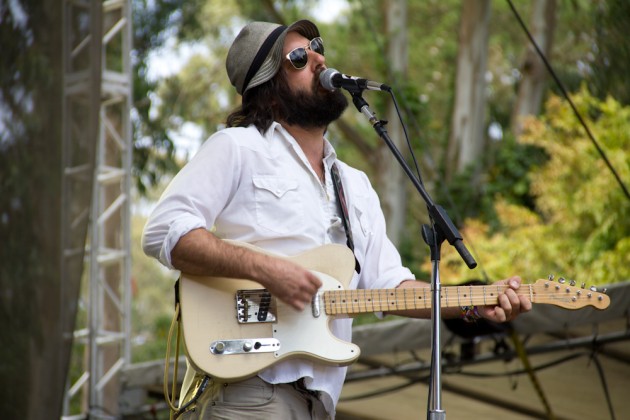
Tune-Yards
tUnE-yArDs hit it big this year with second album WHOKILL, but the triumphant festival set was kicked off with older jam “Do You Want To Live.” This gave the band the opportunity to take to the stage gradually, with only Merrill Garbus on at the start, allowing herself to build the song’s drum and vocal loops, the bassist appeared shortly followed by two saxophonists. This staggered introduction was deserved as each member played a key part in bringing the tUnE-yArDs party to life. Second song “Gangsta,” heralded by Garbus’ siren-like vocals, got things cooking, but it was “Es-So” that got things bubbling over. By the time the band dropped “Bizness” the freaks were out in full force, with horse-heads on sticks, people with head gear akin to turntable.fm avatars and even someone dressed as the wolf in nightgown from Little Red Riding Hood all seen dancing in the crowd. The dual saxophones oozed their way through the songs, but Garbus ran the show, providing the heartbeat with her drumming and audible vocal point in her idiosyncratic vocals. All things combined, tUnE-yArDs’ performance was by far the mostcolourful of the festival.
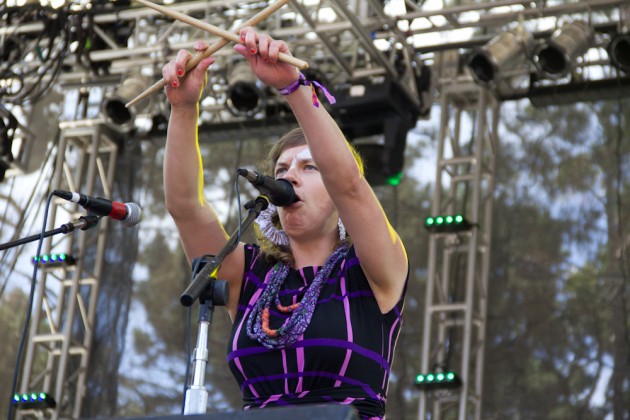
Mavis Staples
I don’t mean to demean fans of other types of music, but you can always count on fans of indie rock to show appreciation for a living legend, even if their musical style may not be exactly what they usually listen to. So, with Arcade Fire and The Decemberists both billed to play later on the main stage, it was the perfect opportunity for Mavis Staples to provide the crowd with something a little different and classy, which she most certainly did. The crowd latched on to the performance of the Jeff Tweedy-penned “You Are Not Alone,” but it was when Arcade Fire’s Win Butler joined Staples onstage to perform a cover of The Band’s “The Weight,” that they really started to get into it. The crowd were ultimately rewarded for their great reception when Staples finished with her classic from her days in the Staple Singers “I’ll Take You There.” The song, at nearly 40 years old, has probably been around longer than most of the audience members, but Staples and her band’s performance on this occasion emphasised that it really is timeless.

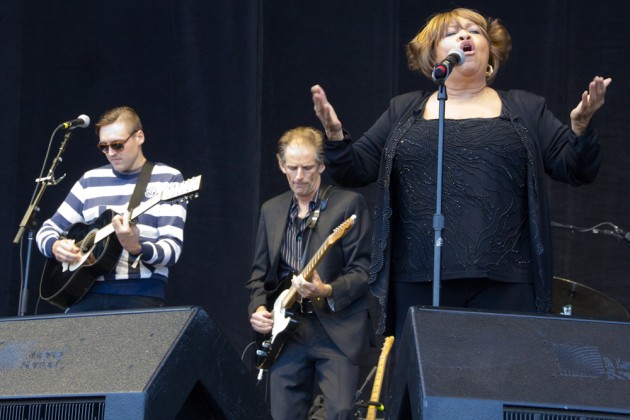
Josh Ritter & the Royal City Band
The sun was already shining on Golden Gate Park when Josh Ritter and his band took to the stage, but if it hadn’t been, I’m pretty sure Ritter’s radiant smile would have parted the clouds with ease. I said it when I saw him in April and I’ll say it again: he is born to perform. In the early portion of the set Ritter and co. stuck to my aforementioned unwritten rules of playing festivals, playing upbeat and catchy old favourites, which included “Other Side” and “Wolves.” But, around the middle of the set the Royal City Band showed that they were unafraid to show off their more experimental side even on a stage as big as this. “Rattling Locks” saw all band members on percussion while Ritter switched to the keyboard to deliver the spooky number. “Change of Time” showed off their ability to bring grandiosity to a festival, with the slow-builder culminating in horns and wrenching vocals. “Harrisburg” even included the standard live vocal interlude and cover of Talking Heads’ “Once In A Lifetime.” The set concluded with the band returning to safe territory and hitting “Kathleen” and “To The Dogs or Whoever” perfectly. Although this was a festival performance on the main stage there was no stopping the band from putting on their usual top-notch live show, and on this form why would anyone want to?
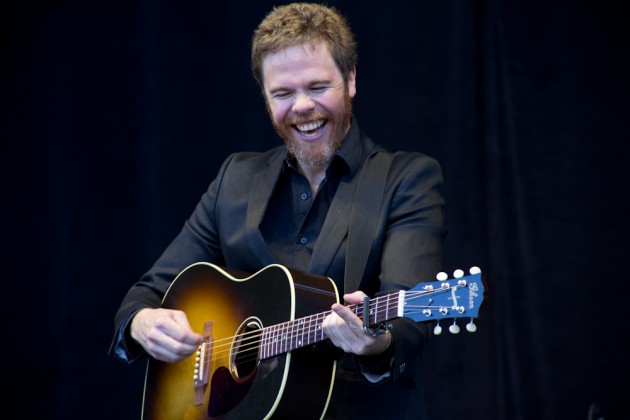
John Fogerty
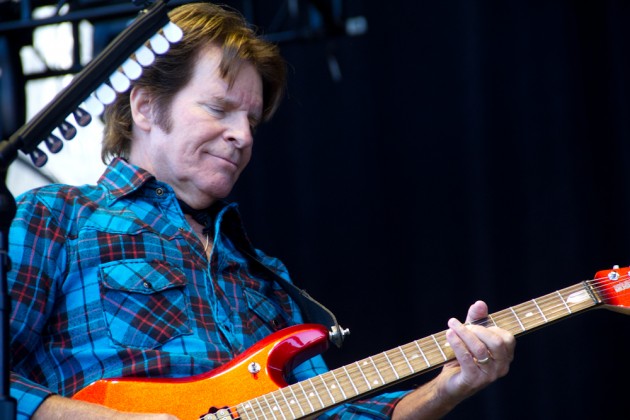
Little Dragon
It wasn’t until I saw them live that I realised how dancey Little Dragon’s music is. New songs “Please Turn,” and “Ritual Union” were highlights, but during the trance-like “Summertearz,” I felt more-like I was watching a rave than a festival set from an indie band. Little Dragon’s three male members Erik, Fredrik and Hakan stay more or less rooted behind their instruments, ensuring that the synths are crisp and the beats are tight. This may sound uninteresting to watch, but fortunately they have one hell of a frontwoman in Yukimi Nagano, who stays active through the whole performance, hopping around and providing ample visual entertainment with her unique and tailored-to-the-beat dance moves. Nagano announced that San Francisco was their favourite place in the world to perform, and it was made clear as to why when the crowd went berserk during the extended and unstoppably infectious “Please Turn.” With fifteen minutes of their allotted time remaining Nagano announced that it was time for their last song. My thought that they were finishing disappointingly early proved foolish; instead the band delivered their biggest song yet which spanned the remaining time and saw the hardcore fans at the front stay moving the entire time. It was a surprising and impressive set from a band that is clearly still on its way to its peak.

The Decemberists
By the evening on the final day of a festival it can get a little gruelling standing in the crowd for so long, but The Decemberists make things a little easier on everyone. They provide upbeat rock songs that you don’t feel you necessarily have to move around to, and you can just stand and admire the musical and lyrical prowess onstage. Colin Meloy also provides extra entertainment with his inter-song banter; on this occasion providing laughs and cheers by announcing that Michele Bachmann should use “Calamity Song” as her official song for her 2012 presidential election campaign. The new material held-up well in a set that was littered with old favourites such as “July, July” and “The Soldiering Life.” “This Is Why We Fight,” saved for near the end of the set, proved to have a soaring chorus worthy of any mass-festival singalong. But it was the mid-set double header of songs from The Hazards of Love, “Won’t Want For Love” and “The Rake’s Song,” that found the band at their most rocking and spectacular. Not satisfied with this level of drama, The Decemberists upped the histrionics for their concluding “The Mariner’s Revenge Song.” This drawn-out tale of people surviving in the belly of a whale and the telling of their life stories probably had just about every possible reaction from different people in the crowd, from horror to bemusement to elation, and I’m sure The Decemberists wouldn’t have it any other way.

Beirut
When I saw Beirut play a few years ago I left with an attitude of seen-one-seen-them-all with regards to his songs performed live. After Zach Condon and his troops’ performance at Outside Lands I left with my opinion somewhat but not entirely changed. “Scenic World” and “Postcards From Italy” both featured inside the opening trio, and it seems that now with three full-length albums under his belt Condon feels confident in playing well-known songs early on, even in a 70-minute festival set. “Nantes” provided a sing along to its lilting chant, and I was pleased to find that “My Night With A Prostitute From Marseille” is still in the setlist; the relative obscurity being quite a contrast to the rest of Beirut’s material, providing something interesting and different while playing to Condon and his band’s strengths. “Goshen” encapsulated everything perfect about scheduling Beirut to play the wooded arena at sunset, capturing the most tranquil instance of the whole festival in a three-minute daydream. The concluding “Gulag Orkestar” had the potential to be great, with its dramatic horn intro, but it lacked a certain je-ne-sais-quoi, which left Beirut’s set finishing a little underwhelmingly. I may have been the only person to have thought so though, since the rapturous fans’ screaming managed to haul Condon back onstage for (what seemed like) an unplanned encore, and one random girl even gave me a hug out of pure happiness (although I can’t give full credit to Beirut for that).
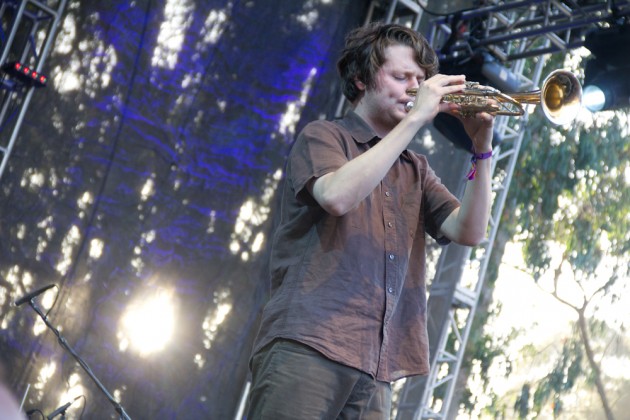

Arcade Fire
Mid-way into Arcade Fire’s set I heard two people discussing who they thought were the superior live band, Arcade Fire or Muse. I’m not sure which conclusion they came to, but for me the answer is clearly Arcade Fire. Muse’s performance is undeniably impressive; they have huge riffs, blinding lights, exemplary musicianship and are polished – categories in which they beat Arcade Fire hands down. But, the reason Arcade Fire still wins out is to do with the audience connection. Muse’s big and bombastic live show is remarkable, but it is just that: a show. Arcade Fire’s performances transcend the barriers between performer and spectator, bringing everyone together in a rousing romp that sees everyone singing along, with or without words. The numbers on stage help too, with six genuinely joyous smiles remaining throughout (Will Butler is too busy throwing himself around like a mad man to smile). If you’re in the moment, it really feels like a religious experience.
These compliments may seem overblown, but they made perfect sense to me as I watched Arcade Fire play at Outside Lands, particularly when they hit numbers from Funeral such as “Rebellion” and “Power Out,” (for which they called upon the crowd to pull out their electrical devices for an eerie illumination effect) and a day later my feelings still feel justified. Another fact that makes the Arcade Fire Experience what it is is that they know which songs to play, and on this occasion that meant mixing a lot of upbeat songs like “Haiti,” “Keep The Car Running” and “We Used To Wait,” with the odd slower song like “Rococo,” and showing no favouritism for any one release, even if they are technically still touring in support of The Suburbs.
In every previous performance I’ve seen from Arcade Fire they have concluded with the magnificent “Wake Up,” so I was surprised to see them play that as the penultimate song, with “Sprawl II” usurping it as finisher. While I still think “Wake Up” is the perfect concluding song, with its soaring group vocals undulating melodies, I now fully appreciate “Sprawl II” as a closer, especially at a festival. The number is Arcade Fire’s most upbeat and unabashed pop song, and will never fail to get a crowd moving, especially one so alive and adoring as that of Outside Lands on Sunday night. When a song has the ability to make people forget their tiredness at the very end of a packed three days of music, then it’s too good not to be the grand finale.
